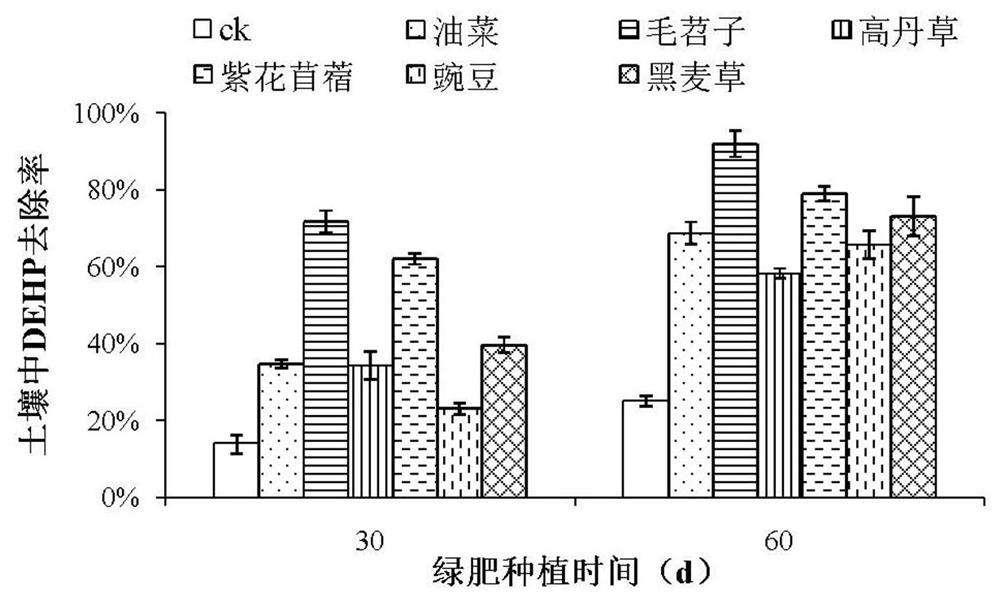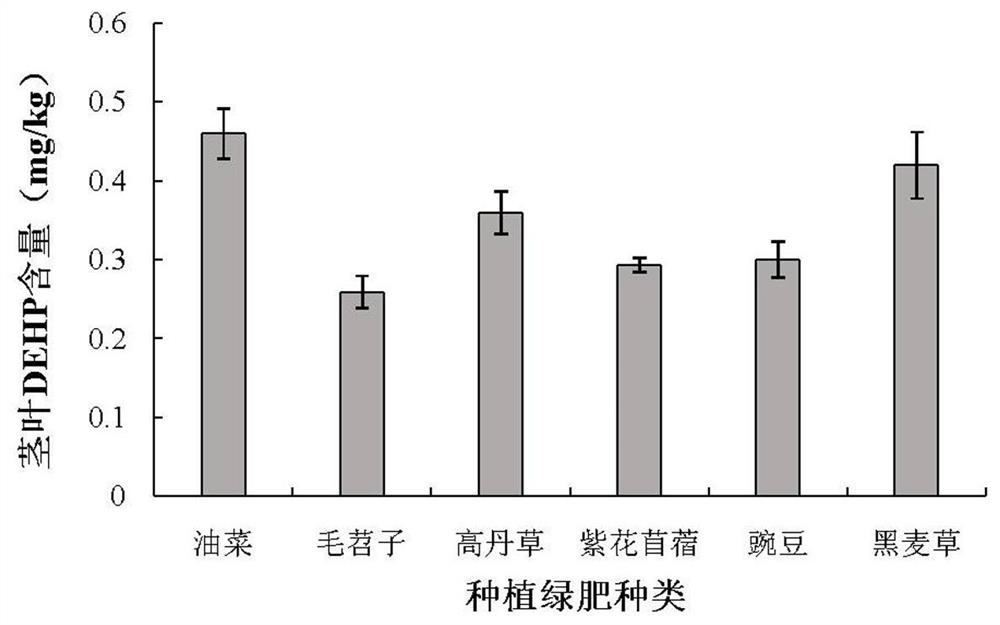Method for repairing phthalate-polluted farmland soil by applying green manure plants
A phthalate ester and phytoremediation technology, applied in the restoration of contaminated soil, etc., can solve problems such as PAEs pollution, and achieve the effects of environmental friendliness, strong adaptability, and promotion of degradation
- Summary
- Abstract
- Description
- Claims
- Application Information
AI Technical Summary
Problems solved by technology
Method used
Image
Examples
Embodiment 1
[0033] A method for applying green manure plants to remediate phthalate pollution in farmland soil, comprising the following steps:
[0034] Step 1: Loosen and level the contaminated soil to be repaired; specifically, loosen and level the soil to be repaired, open drainage and irrigation ditches, apply basal fertilizer, and irrigate until the soil is moist, so that the soil water content reaches about 70% of the soil water holding capacity.
[0035] Step 2, planting alfalfa or A. alfalfa in the polluted soil; specifically, soaking the alfalfa or A. alfalfa seeds in warm water for 24 h before sowing, and then sowing into the polluted soil; wherein, the seeding amount of alfalfa is 1.5-2 kg / mu , the sowing rate of thorn seed is 3-4 kg / mu; the method of spring or autumn sowing is adopted, and the growth period is 45 days to 65 days.
[0036] Step 3: Detecting the content of PAEs in the reconditioned contaminated soil; the detection results satisfy the total concentration of 6 PAE...
Embodiment 2
[0043] Green manure test for indoor pot planting
[0044]The indoor pot experiment was carried out with DEHP, which has the highest pollution concentration and is more difficult to degrade in soil, as the representative PAEs pollutant. The soil tested was a 0-20 cm layer of yellow-brown soil (32°01′58″N, 118°52′15″E) collected from farmland in Nanjing, Jiangsu Province, with a pH value of 7.24 and an organic carbon content of 7.44 g / kg, the clay content was 27%. The yellow-brown soil was air-dried to remove sundries such as plant roots, and passed through a 2 mm stainless steel screen. A portion of the sieved soil was taken to prepare 0 and 5000 mg / kg DEHP-contaminated parent soil. Take 1% of the contaminated mother soil and 99% of the sieved soil and mix them thoroughly to prepare DEHP-contaminated soil of 0 and 50 mg / kg.
[0045] Put DEHP-contaminated soil into a glass jar (30 cm*20 cm*20 cm) with a soil depth of 15 cm. The soil water content was adjusted to 50% of the ...
Embodiment 3
[0052] Indoor experiment of green manure turning and pressing
[0053] The soil source, properties, preparation method and concentration of PAEs pollution used in the test are the same as those in Example 1.
[0054] Mix 2 kg of DEHP-contaminated soil with 10 g of crushed fresh alfalfa or A. alfalfa stems and leaves, and put them into a ceramic pot. Adjust the soil water content to 50% of the maximum water holding capacity in the field, cultivate at a constant temperature in an artificial greenhouse at 25°C, and replenish water regularly to maintain soil moisture.
[0055] After culturing for 45 days, soil samples were collected to determine the residual amount of DEHP in the soil, and the removal rate of DEHP in the soil was calculated according to the initial concentration of DEHP pollution in the soil ( image 3 ).
[0056] Depend on image 3 It can be seen that the soil DEHP pollution has a significant remediation effect after returning to the field. After returning to ...
PUM
 Login to View More
Login to View More Abstract
Description
Claims
Application Information
 Login to View More
Login to View More - Generate Ideas
- Intellectual Property
- Life Sciences
- Materials
- Tech Scout
- Unparalleled Data Quality
- Higher Quality Content
- 60% Fewer Hallucinations
Browse by: Latest US Patents, China's latest patents, Technical Efficacy Thesaurus, Application Domain, Technology Topic, Popular Technical Reports.
© 2025 PatSnap. All rights reserved.Legal|Privacy policy|Modern Slavery Act Transparency Statement|Sitemap|About US| Contact US: help@patsnap.com



